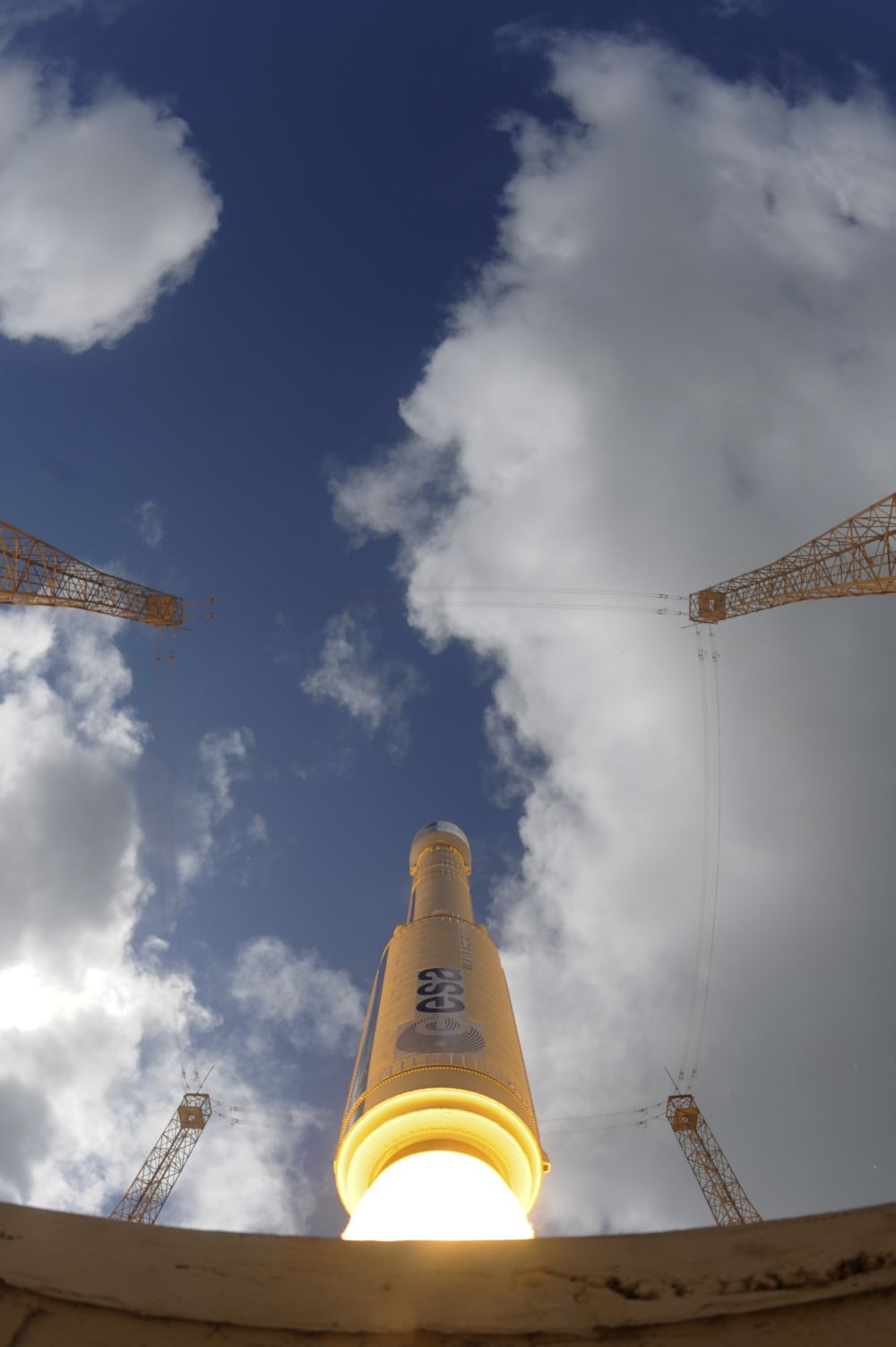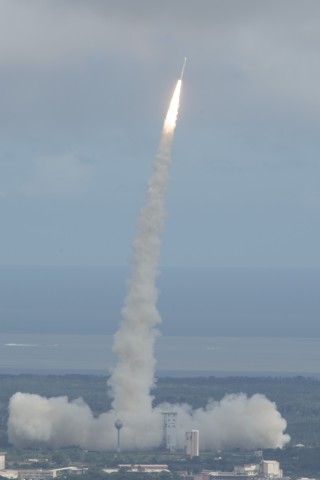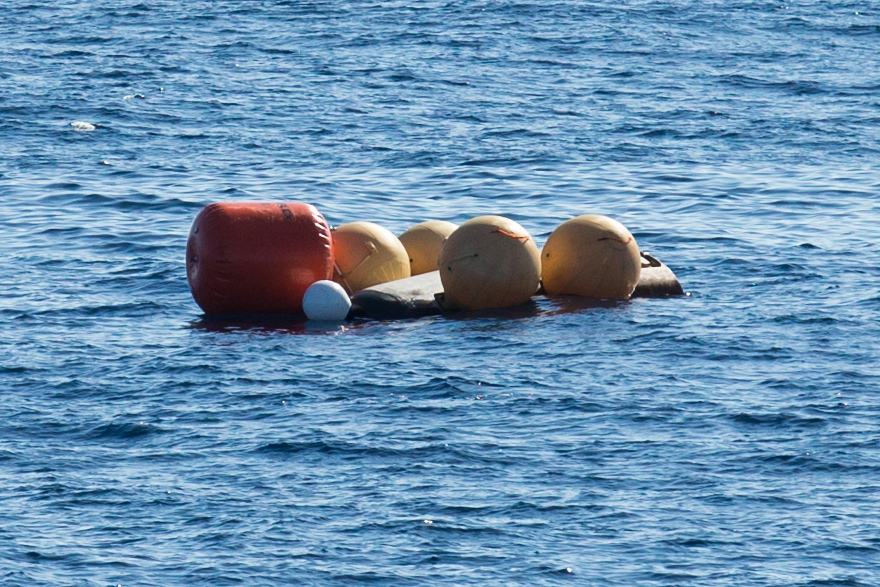
It wasn’t Superman, but a spaceplane; however, it sure appeared to travel “faster than a speeding bullet,” as it cleared the pad in four seconds.
At 13:40 GMT (8:40 EST) today, the flight of the European Space Agency’s (ESA) Intermediate eXperimental Vehicle (IXV) was underway as the spaceplane’s Vega launch vehicle leaped off a pad at Europe’s Spaceport in Kourou, French Guiana. According to ESA, IXV then embarked on a “flawless reentry,” providing the space agency with valuable data aiding future spaceflights during its 100-minute mission. The mission was also described as a “milestone” for Vega, which was introduced in 2012 as a launch vehicle for small payloads headed to low-Earth and polar orbits.
After a brief hold, IXV—which resembles a wingless space shuttle and is about the size of a car, with a length of five meters—was on its way to a suborbital trajectory as the Vega vehicle lofted it into space, clearing the tower rapidly. Today’s launch was the first time a Vega launcher has flown a suborbital mission; the launch was delayed from November 2014 to today as engineers required extra time to analyze this trajectory. According to ESA, today’s launch marked the first time Vega took an equatorial launch trajectory, as opposed to launching northward. In addition, IXV was the heaviest payload Vega has supported to date, at 1,900 kg (approximately 4,200 pounds).
Replay of Vega’s liftoff, carrying ESA’s IXV spaceplane. Video credit: ESA
Following vehicle separation, which occurred at 348 km (216 miles), IXV continued to coast up to an altitude of 413 km (258 miles). The spaceplane then begin its descent at 7.5 km/s (4.7 miles per second) at an altitude of 120 km (approximately 75 miles), positioning itself for reentry. This descent rate mimics conditions a vehicle would experience coming back from low-Earth orbit during reentry. According to the mission time line previously laid out by ESA, the mission’s milestones occurred just as expected. IXV then rode under the power of parachutes to a watery “home” in the Pacific Ocean, where it was nabbed by the Nos Aries recovery ship.

Outfitted with 300 sensors, IXV recorded data throughout its flight; initial results will be released six weeks from now. As for now, the spaceplane is headed to ESTEC in the Netherlands for further analyses. According to ESA, it is hoped the data gleaned from this mission will “open a new chapter for ESA … Such a capability is a cornerstone for reusable launcher stages, sample return from other planets and crew return from space, as well as for future Earth observation, microgravity research, satellite servicing and disposal missions.”
ESA also announced that findings from this mission may possibly influence the development of a future spaceplane for Europe, stating, “The results will feed the Programme for Reusable In-Orbit Demonstrator for Europe, or Pride, which is being studied under funding decided at ESA’s last two Ministerial Councils.” Pride, similar to the United States Air Force’s secretive X-37B, would be reusable and would perform automated landings on a runway. It, too, would launch utilizing a Vega rocket. While Europe previously has had a spaceplane in its sights (Hermes, proposed in the 1980s initially as a CNES project), it never made it past the initial planning stages, and the project was canceled in the early 1990s.
Enthusiasm ran high following the success of this historic mission for ESA. “IXV has opened a new chapter for ESA in terms of reentry capabilities and reusability. ESA and its Member States, together with European space industry, are now ready to take up new challenges in several fields of space transportation, in future launchers, robotic exploration or human spaceflight,” said Jean-Jacques Dordain, ESA Director General.
Giorgio Tumino, IXV project manager, added: “This was a short mission with big impact. The cutting-edge technology we validated today, and the data gathered from the sensors aboard IXV, will open numerous opportunities for Europe to develop ambitious plans in space transportation for a multitude of applications.”
This successful flight continues a year of high-profile victories for ESA, as the space agency also made the seemingly impossible visions of science fiction a reality with its Rosetta cometary mission. In American spaceplane developments, Sierra Nevada Corporation (SNC) is continuing to develop its Dream Chaser vehicle for possible commercial flights despite not landing a Commercial Crew contract from NASA last year; the X-37B is also expected to make another flight this year.

Want to keep up-to-date with all things space? Be sure to “Like” AmericaSpace on Facebook and follow us on Twitter: @AmericaSpace



